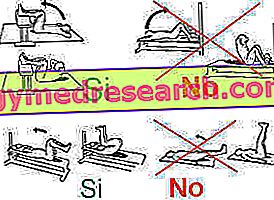Watch the video
X Watch the video on youtubeMessage sent by: Silvia
Hi Silvia,
I will list below a series of possible causes that may have led to an increase in your life point
-for cortisol production and increased life: stress and infrequent meals.
If in recent times you have undergone significant psycho-physical stress, if you sleep for a few days and too long for others, if you skip snacks and breakfast, if you train too long and / or fast thinking that this may favor weight loss then it's time to run for cover.
Your problem could be linked to overproduction of cortisol, also known as a stress hormone. To regularize the secretion of this hormone, which is responsible among other things for the accumulation of fat in the abdominal region and the loss of muscle mass in the lower limbs, it is necessary:
regularly eat snacks and breakfast, avoiding letting more than 4 hours pass between meals and up;
balance meals properly (especially avoiding excessive amounts of simple sugars)
avoid fasting training
avoid training too long (even if it's not your case since you write)
adopt a healthy lifestyle, allow yourself the right time to rest, limit stress as much as possible and follow a balanced diet
- wrong workouts

Let us explain ourselves better. The main exercises performed for toning and strengthening the abdominal muscles, require the pelvis to approach the chest. This action can be carried out by bringing the chest closer to the pelvis (crunch) or by bringing the pelvis closer to the chest (reverse crunch). Be careful though! I talked about pelvis, not legs, in fact the abdominal muscles have no insertion on the lower limbs. It follows that any exercise that involves any movement of the lower limbs is not physiologically correct to train the muscles of the abdomen. The same goes for all those exercises that see the feet bound to a support like the classic sit up.

In this case, it is necessary to rearrange the correct muscular balance: learning the correct technique for performing the exercises that stimulate the abdominal muscles, strengthening and stretching the buttocks and hamstrings, and stretching the iliopsoas muscle.
- incomplete training:
if on the one hand the apparent increase in waistline can be caused by excessive or wrong training, on the other hand it can be a consequence of insufficient training.
The abdomen is not formed by a single muscular belly but by the set of more muscles that must be properly trained. As Roberto Rillo explains in his article "you want a flat abdomen, don't do a flat workout" the traditional training programs mainly go to train the rectus abdominis leaving out all the others. In reality, to obtain the maximum results in terms of reducing the waist, it is necessary to train all the muscles that make up the abdominal belt (rectum, transverse, oblique, lumbar, square of the loins, etc.).
In particular, there is an internal muscle called transverse of the abdomen whose main function is precisely to contain the abdominal organs. To train this muscle requires a great capacity for conscious recruitment of muscle fibers. In other words, we must learn to perceive its contraction by performing exercises in a slow and controlled way, exhaling forcefully during the contraction of the abdominals and taking maximum care of the closing phase (of the pelvis on the chest or vice versa). You can also train this muscle during the day by exhaling strongly and contracting the abdominals first and then pulling the belly in (the two actions must take place simultaneously: contract, keep the contraction and pull the belly in without succeeding)
-food intolerance
Even if I consider the hypothesis quite remote, the increase in your waist could be due to one or more food intolerances. In this case it would be a simple swelling and not an accumulation of fat. To eliminate this possible cause you should, of course, avoid those foods that are difficult for you to digest.
- incorrect posture:
if your life habits lead you to take incorrect correct postures, if you stay in the sitting position for a long time, remember to keep your feet in contact with the ground, your shoulders and eyes straight and the back rests well against the spine.
If you are not in one of the situations listed above the only valid explanation for the increase in your waist is the accumulation of fat as a result of a positive energy balance. In simple terms it means that in the last period you have consumed fewer calories than you introduced with food and this energy surplus has turned into storage fat. The solution in this case is the daily caloric reduction and / or the increase in physical activity.
OTHER POSSIBLE SOLUTIONS WITH MODEST EFFECTIVENESS
Abdominal creams and bands: hyperthermia promotes circulation by increasing blood flow in the area of interest, which is why these products can somehow facilitate the disposal of excess fat and reduce the waist
The draining products promote the elimination of toxic substances, eliminating toxins and excess liquids. It is now widely demonstrated that excessive intake of food toxins, combined with prolonged exposure to other pollutants in the air, favors the accumulation of fat. Minimizing the intake of toxic substances, and facilitating their elimination means laying the foundations to favor detoxification mechanisms.
Massages can also play a positive role, stimulating the circulation of the area affected by localized fat and increasing the sense of general well-being.



